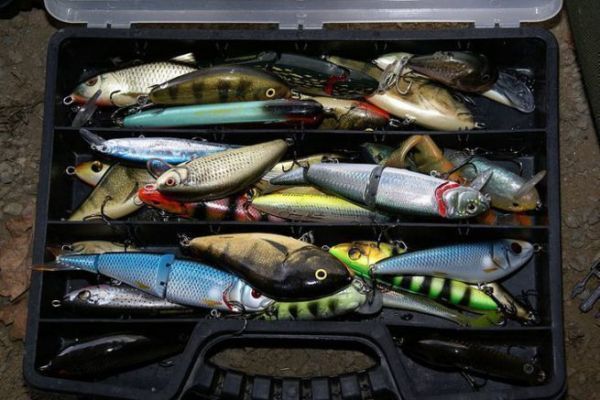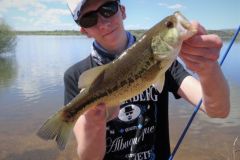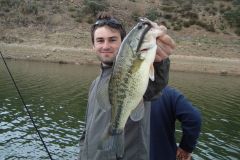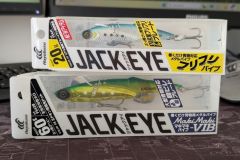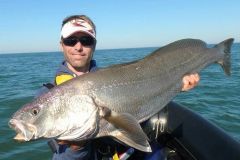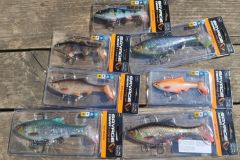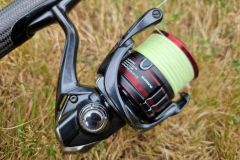3 tips for navigating the jungle of lures available
- To start fishing with swimbaits, it is not necessary to have a full box of lures if you do not know how to use them.
- It is recommended to have in your box one or two lures of each category and to know how to animate them in order to understand their functioning.
- Afterwards, to increase your range, do not hesitate to ask your retailer for advice.
1 - Top water lures without bibs and floats
They evolve on the surface of the water, they have the particularity to imitate the hunting of carnivorous fish in fresh water as in sea.
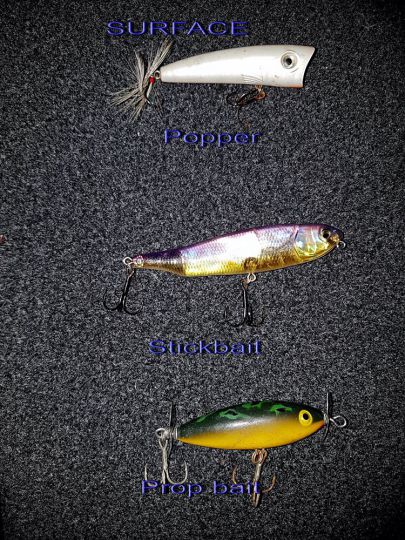
Poppers
They are often equipped with a curved or concave mouth so as to emit more or less powerful sounds with each shot. Each popper emits a particular sound. Some have one or more balls to provoke attacks.
Animation must be slow and discreet in the absence of current (as on lakes) or wind and, on the contrary, fast on currents and riffles: "Pop.pop.popâeuros¦âeuros¦Pop".
The more concave the face of the popper, the louder and more muffled the sound will be.
Stickbaits or Pencil baits
Their name comes from their elongated shape.
Particularity: they slide on the water from right to left like a snake, in zigzags (walking the dog).
Animation is done by small strokes of scions by synchronizing the rotation of the reel and low rod.
Among these swimming fish, several have balls in order to propel them to long distances and thus emit high to low sounds.
Propeller fish (Prop baits / Propellers)
Elongated shape with the characteristic of being provided with metal propellers at the front and/or at the back (from 1 to 3 propellers).
For animation these lures will be animated by small shots in order to create emulsions of small drops of water (as if fry were jumping out of the water).
They make sounds that are intermediate between a popper and a stickbait.
Top Wobblers (wobbling on the surface)
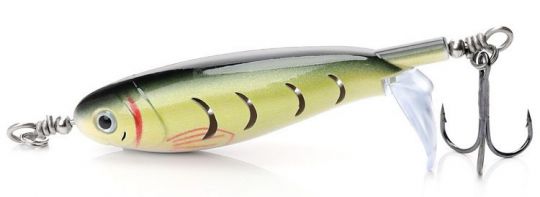
Thanks to their appendages like wings or their particular bib, they emit strong vibrations and strings of bubbles on the surface. They are useful to prospect vast calm zones.
2 - Subsurface lures with a small bib or without bib (Jerk bait minnow)
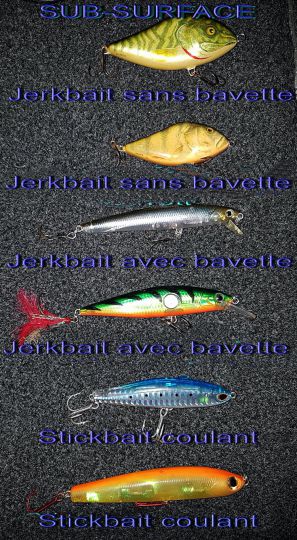
Some of them have a very small bib while others have none. They have the particularity to evolve under the surface of the water (swimming depth: 50 cm). Others can go deeper, but never more than 1,50 m otherwise we will classify them in another family.
They perfectly imitate fleeing fish, which has the effect of exciting predators like perch and pike.
Their animation consists of a slow to fast retrieve interspersed with short stops. These lures are off balance at the slightest stroke of the tip of the rod, which has the effect of provoking an attack. Some remain suspended, brought back to a few meters then stopped: they remain motionless until the animation is resumed.
The Jerkbait has the particularity of being able to fish over grass or rocks, in shallow areas. It is ideal for searching for perch, pike and black bass.
The Stickbaits lipless minnows have the same swimming action as surface minnows, but they move below the surface. They are useful when the fish do not pierce the surface to attack the lure.
3 - Open water lures (medium and large bibs)
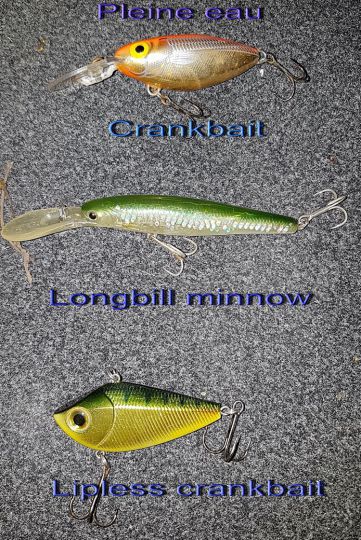
Floating or sinking, these swimming fish are very versatile, it is possible to put them in all hands, from the beginner to the experienced fisherman.
Sound animation pleases due to the powerful vibrations it emits.
Rounded or oval in shape, with a prominent lip, they oscillate and comb the layers of water. The longer the lip, the faster the lure will sink when retrieved. The wider the lip, the greater the vibrations emitted.
A advantage for floating lures with a large bib: when retrieving from obstacles, the bib is used as a shield, it hits a branch, we stop the retrieve of this one so that the lure goes back to the surface, then we retrieve without having pricked his lure in the branch.
Paying technique it is also possible to fish on sandy beaches by tapping the bottom with the bib (bottom-taping), which has the effect of creating sand emulsions (illusion of a small fish looking for food on the bottom).
Pike, perch, black bass, pike-perch, catfish and even marine carnivores cannot resist it.
The Crankbaits (round and chunky) are most often animated by throwing / dragging with stops. Mostly floating.
The longbill minnows have a big bib and are thin of body, they move like the jerkbaits minnows, but deeper (3 m see 6 m for some).
The Lipless crankbaits no flap and ring on the back, their particularity is to emit very strong vibrations. Almost all are equipped with balls to increase the sound. They are sinking swimmers that are thrown far and let sink before being retrieved by more or less ample jerks. The other animation consists of just throwing and dragging, interspersed with micro pauses.
Benefits the sound of the lure sweeps the water and attracts predators from far away. This lure is capable of attracting beautiful specimens, because a small fish which releases so much energy attracts the covetousness of large predators (for the anecdote, in the Loire, catfish of more than 2 meters have been caught with this kind of lure)
Disadvantages little used by fishermen, because it often gets stuck in obstacles (lily pads, branchesâ??)
4 - Big bait / Pull bait
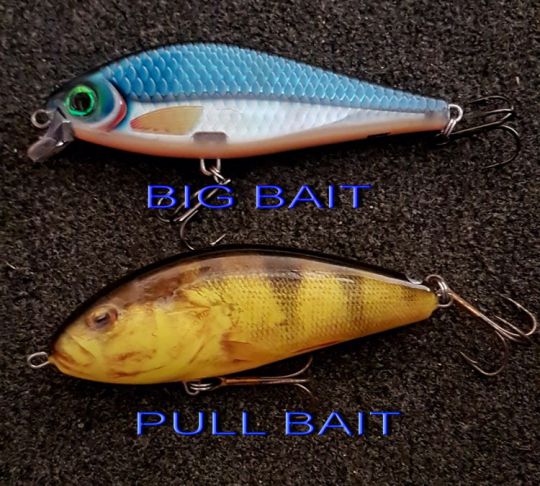
Their particularities: they are heavy (50 to 180 g or more), long or big (25 cm and more). They are mainly used for pike fishing and possibly catfish. They are animated like the others with the only difference that the material is much more powerful.
5 - Articulated lures: Swimbaits
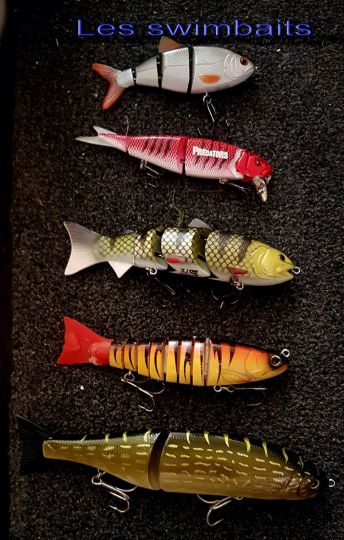
They look like real fish on the retrieve. The more joints the lure has the faster it will swim. For example with 2 joints the lure will swim very slowly. I would bring it in slowly or in short twitches with stops. If my lure has 7 joints, I would bring it back faster and make micro pauses.

 /
/ 